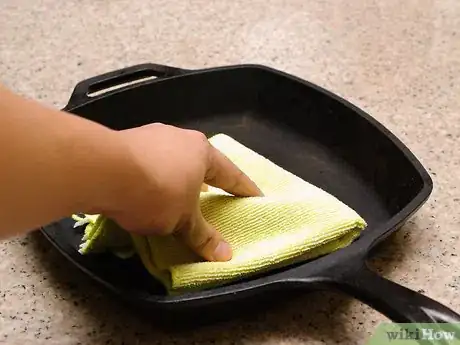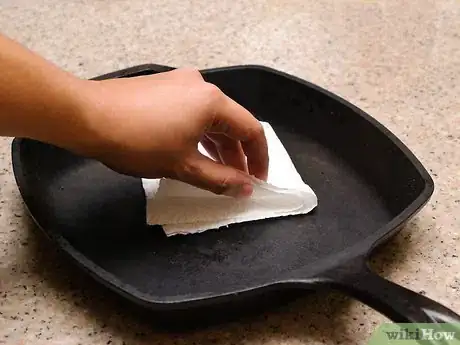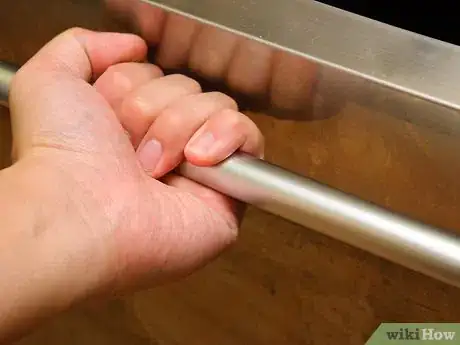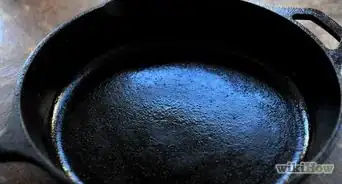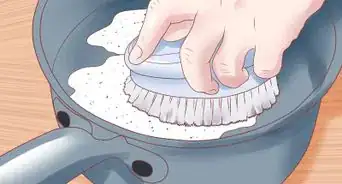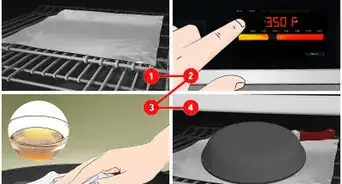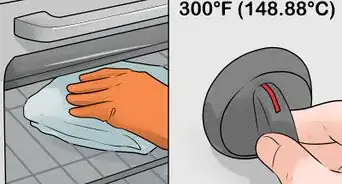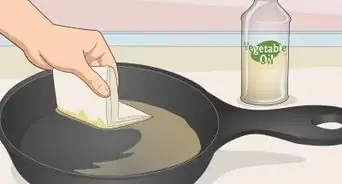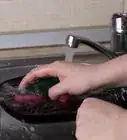This article was co-authored by Kadi Dulude. Kadi Dulude is a House Cleaning Professional and the Owner of Wizard of Homes, a New York City-based cleaning company. Kadi has over 10 years of experience and manages a team of over 90 registered cleaning professionals. Her cleaning advice has been featured in Architectural Digest and New York Magazine.
There are 12 references cited in this article, which can be found at the bottom of the page.
wikiHow marks an article as reader-approved once it receives enough positive feedback. In this case, 85% of readers who voted found the article helpful, earning it our reader-approved status.
This article has been viewed 133,354 times.
A cast iron skillet that is cared for properly can last for the rest of your life. Seasoning the skillet and cleaning it with salt and vinegar will preserve its natural nonstick surface and keep it from getting rusty. If you want to learn how to keep your skillet in good working condition, see Step 1.
Steps
Washing the Skillet After Use
-
1Wash it right after use. Try to get to it before the food you cook has a chance to crust over the skillet. This makes cleanup a lot easier. Simply wipe out the food scraps with a sponge and then rinse the skillet with hot water.[1]
- You can use a touch of regular dish soap to help dislodge sticky food, but don't use too much. Never use bleach or any kind of harsh cleanser.
- Never put your cast iron skillet in the dishwasher.[2] The detergent will corrode the iron.
-
2Remove built-up food with salt and vinegar. If the bottom of the skillet has a layer of caked-on food, make a mixture of coarse salt and vinegar and use a paper towel to rub it around the bottom of the skillet. It's easier on the iron than a scrub brush would be, and less likely to remove the nonstick seasoning.[3]
- You can also burn off caked food. Turn up the oven to 500 °F (260 °C) and put the skillet inside for an hour or so. The food will turn to ash, and you'll be able to brush it off and rinse the skillet.
- However, if you use this method you'll need to re-season the skillet, since that will get burned off as well.
Advertisement -
3Dry the skillet thoroughly. Leaving wet spots on the skillet will lead to rust. After washing the skillet, use a dishcloth to dry it all over, including the handle.[4]
-
4Store the skillet in a dry place. If you're stacking it with other pans, you might want to line the skillet with a paper towel to make sure that no moisture gets trapped between them and protect the seasoning from getting scratched off.[5]
Seasoning a New Skillet
-
1Preheat the oven to 350 ºF. To season a brand new cast iron skillet, you rub it with oil and bake the oil into the surface of the cast iron. This builds up a nonstick coating, called the "seasoning," that keeps the skillet from rusting and creates the perfect surface for cooking everything from scrambled eggs to pancakes to cobblers.[6]
-
2Wash and dry the new skillet. Use hot, soapy water and a scrub brush to scrub the skillet completely clean. This will remove any chemicals or other residues from the skillet so they don't get trapped in the seasoning.[7]
- After this first washing, you won't be using a scrub brush on the skillet again, since it will take off the precious seasoning you'll be working to preserve.
- Make sure to dry the skillet well, so that it doesn't create steam when you put it in the oven.
-
3Coat the skillet with fat. You can use flaxseed, vegetable shortening, or olive oil. Use a paper towel to rub the fat into the skillet all over. The fat will bake into the skillet and fuse with the iron to become a layer of seasoning. You won't be able to taste or smell it once the process is complete.[8]
- Try not to miss any spots when you're covering the skillet with fat. If you miss a spot, it won't get a coating of seasoning, and will be more prone to rusting.
-
4
-
5Repeat the process. Spread another coating of fat onto the skillet and bake it for another 2 hours, then let it cool. If you'd like, you can repeat it one more time to make extra sure that the seasoning won't strip off when you cook your first meal in the skillet. After this initial seasoning, the oil you use when you cook food will keep the skillet in good shape. Every time you cook a meal, the nonstick surface will improve.[11]
Dealing With Rust
-
1Soak the skillet in a vinegar solution. This will eliminate the rust, and it works no matter whether you have a few spots or the entire skillet has gotten rusty. Get a big pot large enough to hold the skillet. Fill it with a solution of half white vinegar, half water. Place the skillet in the pot and make sure it's completely submerged. Soak it for at least 3 hours so the vinegar has time to dissolve the rust.[12]
- When you remove the skillet, check for rust. If you still see rust spots, use a scrub brush to scrub them away.
- Don't soak the skillet for more than 4 hours, or the iron will start to degrade. You just want to soak it long enough to take off the rust.[13]
-
2Rinse and dry the skillet. Rinse off all of the vinegar, then use a dish towel to completely dry the skillet.[14]
-
3Coat it with fat. Just like you would for a brand-new skillet, use a paper towel to rub lard, olive oil or vegetable oil all over the skillet. This will become the skillet's new seasoning.[15]
-
4Bake the skillet for 2 hours. Put it in an oven preheated to 350 °F (177 °C). After 2 hours, remove the skillet and let it cool completely.[16]
-
5Repeat the process. Coat it in another layer of oil, bake for 2 hours, and allow it to cool again. The once-rusty skillet should now have a protective layer of seasoning.
Expert Q&A
Did you know you can get expert answers for this article?
Unlock expert answers by supporting wikiHow
-
QuestionWhat can I use to scrub my skillet?
 Kadi DuludeKadi Dulude is a House Cleaning Professional and the Owner of Wizard of Homes, a New York City-based cleaning company. Kadi has over 10 years of experience and manages a team of over 90 registered cleaning professionals. Her cleaning advice has been featured in Architectural Digest and New York Magazine.
Kadi DuludeKadi Dulude is a House Cleaning Professional and the Owner of Wizard of Homes, a New York City-based cleaning company. Kadi has over 10 years of experience and manages a team of over 90 registered cleaning professionals. Her cleaning advice has been featured in Architectural Digest and New York Magazine.
House Cleaning Professional
-
QuestionWhat fat should I use to season my cast iron skillet?
 Kadi DuludeKadi Dulude is a House Cleaning Professional and the Owner of Wizard of Homes, a New York City-based cleaning company. Kadi has over 10 years of experience and manages a team of over 90 registered cleaning professionals. Her cleaning advice has been featured in Architectural Digest and New York Magazine.
Kadi DuludeKadi Dulude is a House Cleaning Professional and the Owner of Wizard of Homes, a New York City-based cleaning company. Kadi has over 10 years of experience and manages a team of over 90 registered cleaning professionals. Her cleaning advice has been featured in Architectural Digest and New York Magazine.
House Cleaning Professional
-
QuestionCan you get a cast iron skillet wet?
 Kadi DuludeKadi Dulude is a House Cleaning Professional and the Owner of Wizard of Homes, a New York City-based cleaning company. Kadi has over 10 years of experience and manages a team of over 90 registered cleaning professionals. Her cleaning advice has been featured in Architectural Digest and New York Magazine.
Kadi DuludeKadi Dulude is a House Cleaning Professional and the Owner of Wizard of Homes, a New York City-based cleaning company. Kadi has over 10 years of experience and manages a team of over 90 registered cleaning professionals. Her cleaning advice has been featured in Architectural Digest and New York Magazine.
House Cleaning Professional
References
- ↑ https://www.cooksillustrated.com/articles/381-how-to-clean-a-cast-iron-pan
- ↑ http://www.southernplate.com/2009/02/how-to-season-a-cast-iron-skillet.html
- ↑ https://www.thekitchn.com/how-to-clean-a-cast-iron-skillet-cleaning-lessons-from-the-kitchn-107747
- ↑ Kadi Dulude. House Cleaning Professional. Expert Interview. 22 September 2019.
- ↑ https://www.thekitchn.com/store-your-cast-iron-with-this-one-thing-to-make-it-last-longer-235234
- ↑ https://www.thekitchn.com/how-to-season-a-cast-iron-skillet-cleaning-lessons-from-the-kitchn-107614
- ↑ https://www.seriouseats.com/2016/09/how-to-season-cast-iron-pans-skillets-cookware.html
- ↑ Kadi Dulude. House Cleaning Professional. Expert Interview. 22 September 2019.
- ↑ https://www.thekitchn.com/technique-seasoning-a-brand-new-cast-iron-skillet-6719
- ↑ Kadi Dulude. House Cleaning Professional. Expert Interview. 22 September 2019.
- ↑ http://www.southernplate.com/2009/02/how-to-season-a-cast-iron-skillet.html
- ↑ https://www.bonappetit.com/test-kitchen/how-to/article/cast-iron-pan-rust
- ↑ https://www.tastingtable.com/cook/national/cast-iron-pan-rust-vinegar
- ↑ https://www.thekitchn.com/how-to-restore-a-rusty-cast-iron-skillet-cleaning-lessons-from-the-kitchn-203086
- ↑ Kadi Dulude. House Cleaning Professional. Expert Interview. 22 September 2019.
- ↑ https://www.bobvila.com/articles/how-to-remove-rust-from-cast-iron/
About This Article
To care for a cast iron skillet, clean it right away after each use. First, wipe down the skillet with a paper towel to remove any food scraps or excess oil. Then, hold the skillet under running warm water and use a nonmetal brush or soft scrubbing pad to scrub the surface of the skillet. Try your best not to use dish soap on your skillet, as soap can strip away some of the pan’s seasoning. Dry the skillet thoroughly by hand to keep it from rusting over time. To finish, add ½ teaspoon (2.5 mL) of vegetable oil to the pan. You do not need to add vegetable oil after cleaning it if you didn’t use soap and the surface still has its grain. Use a paper towel to spread the oil around the interior of the skillet, and let the pan cool before storing it. To keep the skillet from getting damaged, never leave food on it, soak it in water, or put it in the dishwasher, since this can destroy the iron. You may need to season your cast iron skillet periodically if it starts to look blotchy, discolored, or it’s heating unevenly. To do this, rub 1 tablespoon (15 mL) of vegetable oil into the surface of the skillet using a paper towel and bake it for 1 hour at 500 °F (260 °C). If you want to learn how to reseason a skillet after you clean it, keep reading the article!


